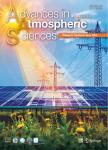A Strategy for Merging Objective Estimates of Global Daily Precipitation from Gauge Observations, Satellite Estimates, and Numerical Predictions
A Strategy for Merging Objective Estimates of Global Daily Precipitation from Gauge Observations, Satellite Estimates, and Numerical Predictions作者机构:National Climate CenterChina Meteorological Administration Center for Earth System Science Tsinghua University Key Laboratory of Atmospheric Science and Satellite Remote Sensing Anhui Institute of Meteorology
出 版 物:《Advances in Atmospheric Sciences》 (大气科学进展(英文版))
年 卷 期:2016年第33卷第7期
页 面:889-904页
核心收录:
学科分类:07[理学] 0706[理学-大气科学] 0816[工学-测绘科学与技术] 0825[工学-航空宇航科学与技术]
基 金:supported by the National Natural Science Foundation of China (Grant Nos. 41275076, 41305057, 41175066, 41175086, and 40905046) the Beijing Natural Science Foundation (Grant No. 8144046) the National High Technology Research and Development Program of China (Grant Nos. 2009AA122005 and 2009BAC51B03) the National Basic Research Program of China (Grant No. 2010CB 951902)
主 题:global daily precipitation multi-source merging strategy bias correction quantitative error estimation
摘 要:This paper describes a strategy for merging daily precipitation information from gauge observations, satellite estimates (SEs), and numerical predictions at the global scale. The strategy is designed to remove systemic bias and random error from each individual daily precipitation source to produce a better gridded global daily precipitation product through three steps. First, a cumulative distribution function matching procedure is performed to remove systemic bias over gauge-located land areas. Then, the overall biases in SEs and model predictions (MPs) over ocean areas are corrected using a rescaled strategy based on monthly precipitation. Third, an optimal interpolation (OI)-based merging scheme (referred as the HL-OI scheme) is used to combine unbiased gahge observations, SEs, and MPs to reduce random error from each source and to produce a gauge--satellite-model merged daily precipitation analysis, called BMEP-d (Beijing Climate Center Merged Estimation of Precipitation with daily resolution), with complete global coverage. The BMEP-d data from a four-year period (2011- 14) demonstrate the ability of the merging strategy to provide global daily precipitation of substantially improved quality. Benefiting from the advantages of the HL-OI scheme for quantitative error estimates, the better source data can obtain more weights during the merging processes. The BMEP-d data exhibit higher consistency with satellite and gauge source data at middle and low latitudes, and with model source data at high latitudes. Overall, independent validations against GPCP-1DD (GPCP one-degree daily) show that the consistencies between B MEP-d and GPCP-1DD are higher than those of each source dataset in terms of spatial pattern, temporal variability, probability distribution, and statistical precipitation events.



